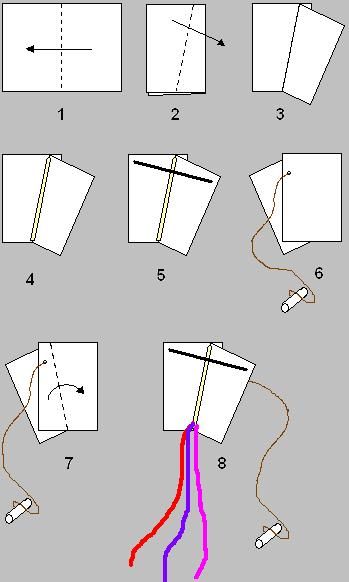? Embark on a Sky-High Adventure: Easy Kite Making for Families
Hello, fabulous kite enthusiasts! Are you ready to tackle a wonderfully windy challenge with your little ones? Making a kite with your family isn’t just a recipe for hours of outdoor excitement; it’s a fantastic opportunity to teach principles of design and aerodynamics, all while tightening the bond between you and your children. So, let’s get ready to spread our wings and soar into the blue with an easy-peasy, DIY kite that is bound to be the envy of the park!
? Materials Needed: Your Kite Making Kit
First things first! To ensure your kite crafting experience is as smooth as a gentle breeze, here’s what you’ll need to gather:
- 1 roll of 1-inch wide colorful plastic ribbon (for the tail)
- 2 wooden dowels – 24 inches and 20 inches in length respectively (for the frame)
- 1 roll of strong tape (duct tape or packing tape works great!)
- 1 large sheet of light but strong plastic (like a garbage bag or a party tablecloth)
- 1 roll of string or twine (for the bridle and the flying line)
- Scissors that bask in the joy of cutting through plastic (safety first!)
- A ruler or tape measure (accuracy equals a majestic flight)
- A marker that’s not afraid to leave a permanent mark
- An optional splash of creativity (stickers, markers, paint for decoration)
Nothing beats the pride of creating something from scratch – especially when it’s done with love and laughter. With these items, you’re on the right track to a successful kite-making adventure.
? Step-by-Step Instructions: Crafting Your Magical Wind Rider
Building a kite is a fun experience, and to keep that fun from turning into a tangled web of confusion, just follow these simple steps:
- Prepare the Frame: Start by crossing the two dowels to form a lowercase ‘t’ shape. The longer dowel should be the spine of your kite while the shorter one will become the crosspiece. Secure them at the center using your tape – a sign of unity for your kite’s framework!
- Cut the Sail: Place your assembled frame on your plastic sheet and trace a kite shape around it, ideally a diamond or a delta, leaving an extra inch for the seams. Embrace your inner artist and cut out the shape with joy and precision.
- Attach the Sail: Fold the plastic edges over the dowels and secure them with tape, like wrapping a gift full of potential fun. Make sure the sail is tight but don’t pull too tight – you wouldn’t want to snap the slender dowels.
- Make the Bridle: Tie a length of string around the intersection of the dowels, and extend it to the top and bottom ends of the vertical dowel. This will balance your kite, giving it the posture of a confident cloud conqueror.
- Add the Flying Line: Now, tie a longer string to the bridle — this ‘bridle line’ will be your direct line to the heavens once your kite takes to the sky. Leave enough length here; more line equals loftier adventures in the wild blue yonder.
- Create the Tail: Cut several lengths of the plastic ribbon and tie them to the bottom of the kite. The tail isn’t just charming; it’s a stabilizer that allows your kite to dance with grace and not spin like a falling leaf.
Do not let any breeze go to waste. With your kite now resembling a vibrant bird eager to test its wings, the anticipation builds. Can you feel it? That’s the rush of preparing for the ultimate launch!
? Decorating Your Kite: Unleash Your Inner Picasso
Kites are more than just flying structures; they’re canvases that touch the sky. Sit down with your kids and let your imaginations take flight. Use bright markers, stickers, or even paint to bedeck your kite with patterns, faces, or inspirational messages. Remember, the best kite is the one that tells a story as it glides — the story of a family’s creativity and teamwork.

? Five Things Parents Should Know in Preparing for Kite Making
Before diving into your whimsical kite-building expedition, there are a handful of pro tips every parent should keep in mind. These pointers will ensure a blissfully smooth experience from start to finish:
- Check the Weather: Good kite flying conditions are essential. A day that’s not too gusty, nor too calm, is perfect. A wind that can flutter a flag is your golden benchmark. Doing a quick weather check can mean the difference between a kite that soars and one that snores.
- Select the Right Space: Choose a spacious and open area free from trees, powerlines, and other potential kite-snagging menaces. Large fields and parks are kite’s best friends, offering them the freedom to cavort without boundaries.
- Involve the Kids: From picking the colors to adding decorations, the more your children are involved, the greater their excitement will be. Let them make decisions, and watch their little eyes light up with ownership and pride.
- Safety Should Reign Supreme: Always supervise your children when making and flying kites. Keep safety scissors on hand, and steer clear of roads or water bodies. We want our kites to fly high, not our little ones taking any unintended dives.
- Patience is a Virtue: Kite making is as much a lesson in patience as it is in craftsmanship. Not every attempt will yield a perfect result, and that’s okay! Celebrate the effort and keep the atmosphere joyful, it’s the best way to learn!
Keep in mind these preparation steps and you’re set to tickle the sky with your very own handcrafted kite!
? Tips for a Successful First Flight
After creating your masterpiece, the true test of its airborne grace awaits. To see your kite rise majestically, here are a few tips that will have you and your kids piloting like pros:
- Gentle On The Strings: Teach your kids the art of gentle guidance. A kite should be coaxed into the air, not yanked voraciously—it’s a dance, not a tug-of-war!
- Wind Reading: Help your children become mini meteorologists. Reading the wind’s direction and speed will serve them not only in kite flying but in many of life’s ventures.
- Launch Teamwork: One person can hold the kite, while another takes the line and runs slightly into the wind. Release the kite and watch your family’s teamwork take physical form, lofting towards the clouds!
- Recovery Tactics: Even the sturdiest kite can plummet. Preparing your kids for this, with an action plan to relaunch, turns setbacks into comebacks and teaches resilience.
With these aerial strategies in your pocket, your day out with the kites will be filled with glee and success.
? Troubleshooting Common Kite-Flying Issues
Sometimes, our high-flying friends encounter a bit of turbulence. Fret not; here’s how to tackle common issues:
- Kite Diving One Way: If your kite keeps diving to one side, check your tail. A longer or heavier tail on the opposite side can restore balance.
- Spinning Kite: Kites that spin out of control can be stabilized by adjusting the bridle or tail length. Symmetry is key, so ensure everything’s even.
- Refusing to Fly: No lift? The bridle might be too tight. Give it a little more slack, so the kite can angle correctly into the wind.
- Sudden Crashes: When a kite takes an unexpected nosedive, it might be too much wind. Dial back the enthusiasm and wait for a gentler breeze.
With these quick fixes, you’ll have your kite cutting through the clouds with the grace of a swan in no time!
?? Keeping Your Kite in Top Condition
The joy of kite flying is boundless, and to keep it alive, proper care is needed. Here’s how to maintain your kite for future escapades:
- Dry Storage: Always store your kite dry to avoid mildew and other unwelcomed spoilage. A clean, dry place will keep it ready for its next flight.
- Minor Repairs: Keep a repair kit handy. Some tape for tears or spare string can go a long way to extend your kite’s lifetime.
- Regular Check-ups: Before each flight, give your kite a once-over. Tighten loose fittings and ensure tails are secure. A healthy kite is a happy kite!
A little TLC can ensure that today’s kite construction fun becomes tomorrow’s flying tradition!
See more great Things to Do with Kids in New Zealand here. For more information see here
Disclaimer
The articles available via our website provide general information only and we strongly urge readers to exercise caution and conduct their own thorough research and fact-checking. The information presented should not be taken as absolute truth, and, to the maximum extent permitted by law, we will not be held liable for any inaccuracies or errors in the content. It is essential for individuals to independently verify and validate the information before making any decisions or taking any actions based on the articles.




